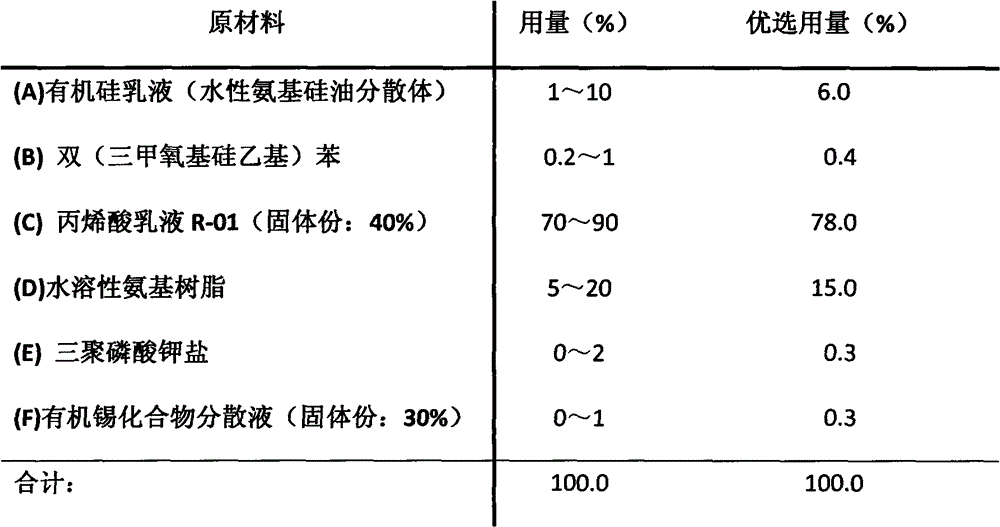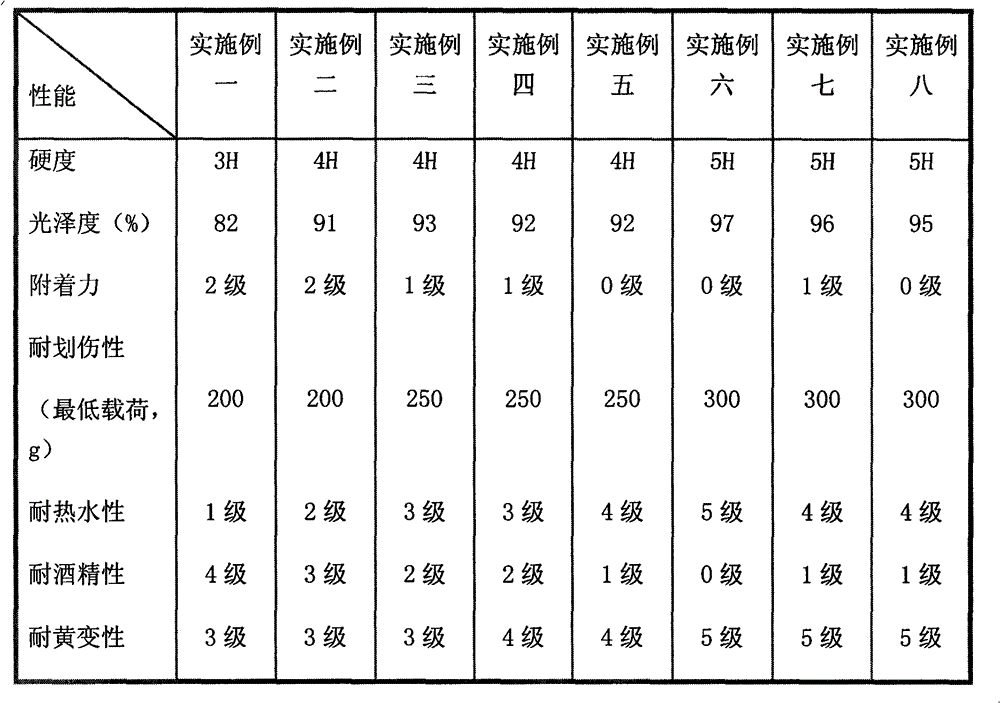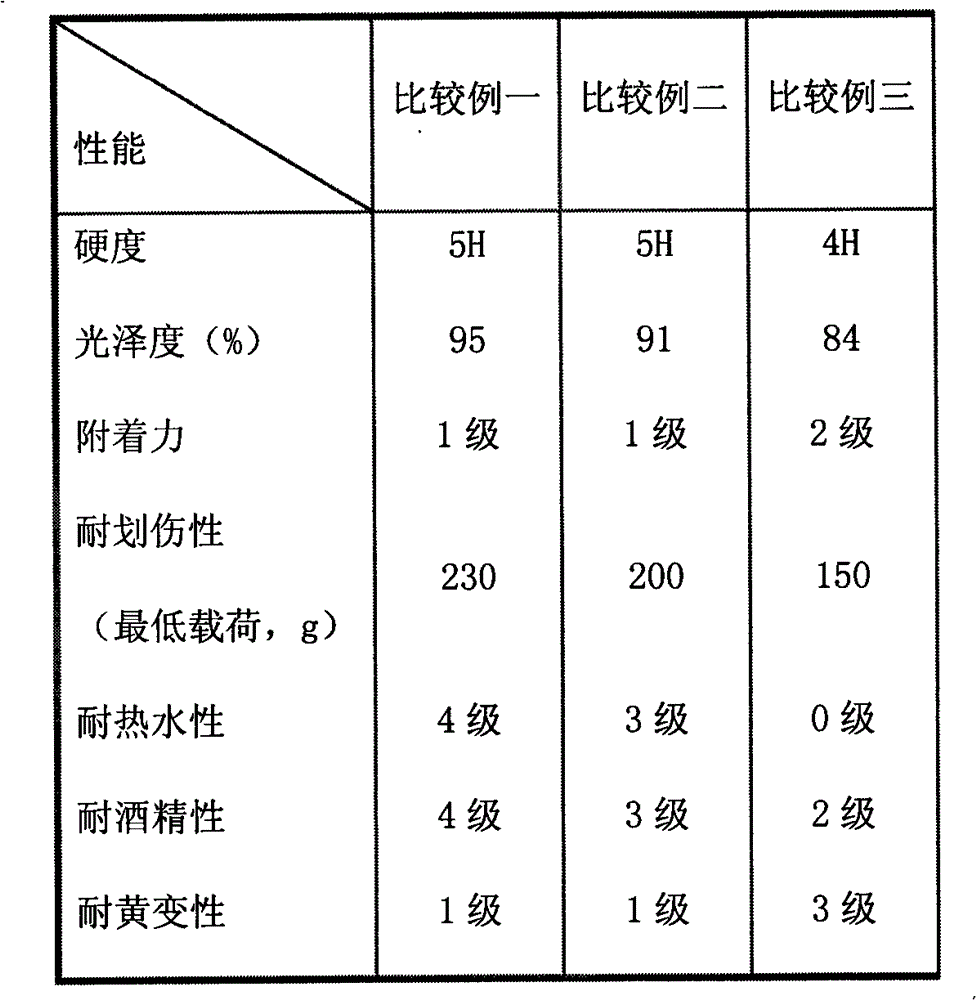Composition for water-based glass bottle baking varnish
A composition, water-based technology, applied in the direction of coating, etc., can solve the problems of overall performance improvement, relatively large decrease in paint film drying speed, no further improvement in alcohol resistance, etc., and achieve the best performance effect
- Summary
- Abstract
- Description
- Claims
- Application Information
AI Technical Summary
Problems solved by technology
Method used
Image
Examples
Embodiment 1
[0013] 1. Synthetic acrylic resin formula table (code: R-01):
[0014] Formula
Dosage
Preferred dosage
A. Nuclear monomer:
0~60
23.8
90~120
104.3
Acrylic
1.5~3
2.4
B. Shell monomer:
60~105
89.4
[0015] Methyl methacrylate
90~105
95.5
Acrylic
16~35
25.9
C. Base material:
Sodium nonylphenol polyoxyethylene ether sulfate (AES)
3.6~4.8
4.2
Octylphenol polyoxyethylene vinyl ether (TX-10)
1.8~2.4
2.2
Dodecyl mercaptan (molecular weight regulator)
0~1.0
0.5
Water
300~360
327.8
D. Initial initiator:
Sodium peroxosulfate
0.3~0.6
0.5
Water
29.7~59.4
39.5
E. Initiator aqueous solution (for dripping):
Sodium peroxosulfate
0.7~0.9
0.8
Water
69.3~89.1
79.2
F. PH value regulator:
0.3~0.7
0.5
Water
2.7~6.3
4.5
G. Neutralizer:
Ammonia (28%)
6.4~15.2
10.3
Water
17.8~44.7
29.7
[0016] Operation method:
[0017] (1) Pu...
Embodiment 2
[0043] The difference from Example 1 is that water-soluble polyamide resin is added to the synthetic formula, which reduces the amount of OP-10 and AES surfactants.
[0044] 1. Synthetic acrylic resin formula table (code: R-02):
[0045] Formula
Dosage
Preferred dosage
A. Nuclear monomer:
0~60
23.8
90~120
104.3
Acrylic
1.5~3
2.4
B. Shell monomer:
Butyl Acrylate
60~105
89.4
Methyl methacrylate
90~105
95.5
Acrylic
16~35
25.9
C. Base material:
Sodium nonylphenol polyoxyethylene ether sulfate (AES)
2.0~4.0
2.5
Polyoxyethylene octylphenol ether (TX-10)
0~1.0
0.3
Water-soluble polyamide resin
5~10
8.0
Dodecyl mercaptan
0~1.0
0.5
Water
300~360
327.8
D. Initial initiator:
Sodium peroxosulfate
0.3~0.6
0.5
Water
29.7~59.4
39.5
E. Initiator aqueous solution (for dripping):
Sodium peroxosulfate
0.7~0.9
0.8
Water
69.3~89.1
79.2
F. PH value regulator:
Embodiment 3
[0054] The difference from Example 2 is that acrylonitrile is added to the synthetic formula
[0055] 1. Synthetic acrylic resin formula table (code: R-03):
[0056] Formula
Dosage
Preferred dosage
A. Nuclear monomer:
[0057] Butyl Acrylate
0~60
23.8
Methyl methacrylate
0~120
68.6
0~90
35.7
Acrylic
1.5~3
2.4
B. Shell monomer:
Butyl Acrylate
60~105
89.4
Methyl methacrylate
11~105
62.8
0~79
32.7
Acrylic
16~35
25.9
C. Base material:
Sodium nonylphenol polyoxyethylene ether sulfate (AES)
2.0~4.0
2.5
Octylphenol polyoxyethylene vinyl ether (TX-10)
0~1.0
0.3
Water-soluble polyamide resin
5~10
8.0
Dodecyl mercaptan
0~1.0
0.5
Water
300~360
327.8
D. Initial initiator:
Sodium peroxosulfate
0.3~0.6
0.5
Water
29.7~59.4
39.5
E. Dropping initiator:
Sodium peroxosulfate
0.7~0.9
0.8
Water
69.3~89.1
79.2
F. PH value regulator:
0.3~0.7
0.5
Wat...
PUM
| Property | Measurement | Unit |
|---|---|---|
| hardness | aaaaa | aaaaa |
| cure temperature | aaaaa | aaaaa |
| cure temperature | aaaaa | aaaaa |
Abstract
Description
Claims
Application Information
 Login to View More
Login to View More - R&D
- Intellectual Property
- Life Sciences
- Materials
- Tech Scout
- Unparalleled Data Quality
- Higher Quality Content
- 60% Fewer Hallucinations
Browse by: Latest US Patents, China's latest patents, Technical Efficacy Thesaurus, Application Domain, Technology Topic, Popular Technical Reports.
© 2025 PatSnap. All rights reserved.Legal|Privacy policy|Modern Slavery Act Transparency Statement|Sitemap|About US| Contact US: help@patsnap.com



